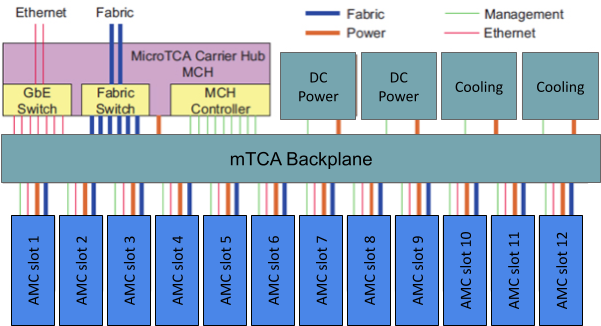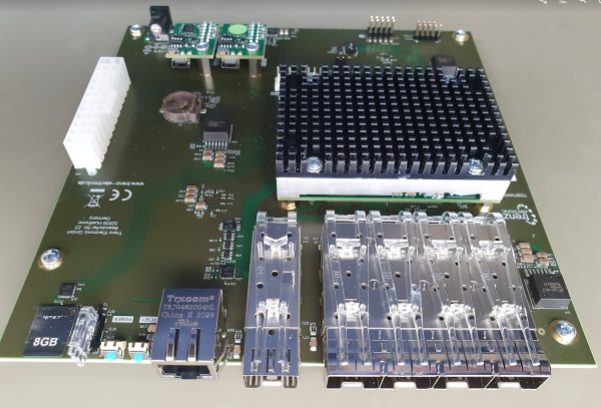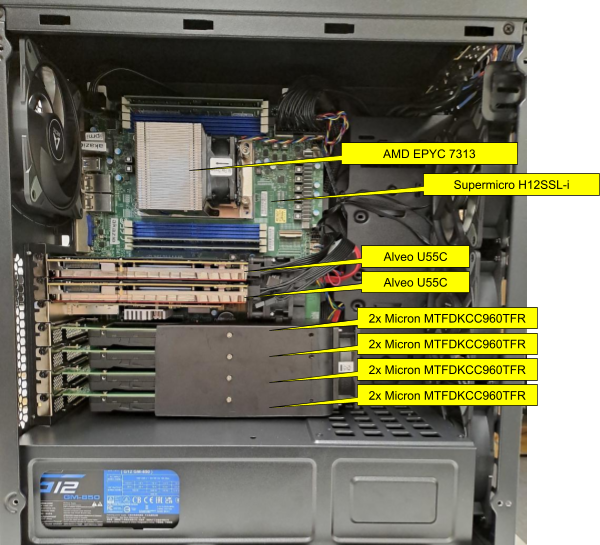FPGA-Based Systems With MicroTCA
Many FPGA-based systems projects are rather low volume and, therefore, favor off-the-shelf hardware over the costs and risks of custom hardware (PCB) design.
MicroTCA or mTCA or µTCA is a 20+ year old standard from PICMG for implementing embedded systems using off-the-shelf hardware. Most often MicroTCA is used for test & measurement or for scientific applications when application specific IOs and signals need to be processed where FPGAs provide the flexibility and processing performance.
However, as we will demonstrate in this Technical Brief, MicroTCA carries a huge baggage, and has little to no advantages over other approaches, namely FPGA based System-on-Modules or the “good old” PC architecture.
Copyright © 2025 Missing Link Electronics. All rights reserved. Missing Link Electronics, the stylized Missing Link Electronics MLE logo are the service mark and/or trademark of Missing Link Electronics, Inc. All other product or service names and trademarks are the property of their respective owners.
What is MicroTCA?
A typical MicroTCA system comprises a chassis plus the so-called MicroTCA Carrier Hub (MCH), which can be redundant, plus multiple so-called Advanced Mezzanine Cards (AMC). The MCH manages the MicroTCA backplane. The AMCs then connect with each other via the backplane using PCIe or Ethernet or else. Here a block diagram of a typical 12 slot MicroTCA system:
Vendors for MicroTCA components include Kontron, NAT, Pentek, Vadatech. AMCs can run the various functions for compute, storage or signal processing. There are choices for different CPUs based on the ARM, PowerPC or x86 instruction set. And, one key reason for using MicroTCA has been FPGA cards implementing different IO standards and signal headers. And while 10 or so years ago MicroTCA was a great choice for building FPGA based systems, the following shall explain why today MicroTCA may not be a good choice anymore.
The fundamental issue with MicroTCA is that FPGAs have advanced significantly over the last decade and now feature rich heterogeneous compute elements with much higher performance, as well as much faster IOs, up to 116 Gbps, all integrated in a more power efficient 5nm / 7nm CMOS technology. That’s why, basically, the SWaPC of MicroTCA has gone bad in comparison to other FPGA system choices, namely FPGA-based System-on-Modules (SoM) or the “good old” PC.
- S as in Size or formfactor is determined by the compute density of FPGAs. And this compute density for MicroTCA is less: In a typical MicroTCA design you may need the resources of multiple FPGAs while one single modern FPGA device would be sufficient.
- W as in Weight – When weight is important such as in airborne or mobile systems the MicroTCA chassis with the AMCs means you schlep a lot of sheet metal – again due to poor compute density.
- P as on Power – Again, this is the result of the poor FPGA compute density of MicroTCA combined with the fact that most AMCs feature very mature FPGA devices. Today’s FPGA technology, however, has improved a lot when it comes to power / energy consumption.
- C as in Cost – MicroTCA never was a cost-optimized architecture but when you compare MicroTCA offerings with today’s many rich choices for off-the-shelf FPGA cards and FPGA System-on-Modules, MicroTCA got worse. By now we have seen price penalties for MicroTCA of 5x or more compared to PC based systems.
Not to forget: MicroTCA is stuck at “old” PCIe Gen3 8 GT/sec while modern FPGAs and PCs are already 2 generations ahead at PCIe Gen5 32 GT/sec.
A Better Option to MicroTCA: FPGA System-on-Modules
As we have described in our Technical Brief TB20231221, FPGA-based System-on-Modules (SoM) can be an incredibly efficient means to implement embedded systems. There are plenty of choices for off-the-shelf FPGA SoMs available in the ecosystem, and in particular with Trenz Electronics, there is always a viable option for a semi-customized SoM variant.
The choices for modern FPGA devices is rich and includes very recent FPGA innovations such as AMD Versal and, soon, AMD Versal Gen2, or Altera’s new Agilex 5.With the ability to design custom carrier boards and/or use them from the many choices of Fabric Mezzanine Cards (FMC) – for example one for NVMe PCIe Gen 4 you can deliver higher signal speeds and better signal integrity. Below an example which implements 1/10 Gig Ethernet connectivity in a custom formfactor at low NRE costs:
Furthermore, when following a simple methodology of “Shift-Left Your Next FPGA Design” you can easily upgrade the FPGA design by switching to a new, drop-in-compatible SoM with a bigger FPGA. That also keeps your NRE costs and risks down during development and during the product lifecycle.
Another Option: The “Good Old” PC
In many cases the modern PC also provides a better option than MicroTCA: Off-the-shelf hardware such as mainboards, PCIe cards and enclosures are available from many vendors, for ruggedized, from the mini-PC over the 19” formfactor all the way to high-performance OCP systems. Below an example of a PC to implement a high-speed data acquisition and recording system:
Your choice for the CPU spans from the bread-and-butter x86 to high-performance AMD EPYC Genua with up to 128 PCIe Gen5 32 GT/sex lanes (which is a > 300 GBytes/sec bandwidth beast). Other choices include ARMv8 with the Ampere Altra, for example.
Plus there are plenty of valuable open source projects available for the PC which are hard to make work in a MicroTCA setting, such as the LabGrid management and automation library, for example.
You can combine this superior price/performance of the PC with many offerings for off-the-shelf FPGA cards, including from AMD Alveo, Alpha-Data, Bittware, Napatech, etc.
In many embedded systems data acquisition (DAQ) and loss-less gap-less recording at high data rates are vital. Here the PC architecture shines with options for Fast FPGA RAID (FRAID) delivering recording speeds of 100/200/400 Gbps. You can add security via the TCG OPAL feature of modern NVMe SSDs, too.
All this makes the good old PC architecture a cost-efficient choice when it comes to better off-the-shelf compute, signal processing and storage density.
Conclusion
As the following table shows, MicroTCA may not be the best option anymore to implement your next FPGA-based embedded system:
|
Aspect |
SoM |
PC |
mTCA |
|
FPGA compute density |
very high |
highest |
low |
|
PCIe bandwidth |
high PCIe 4.0 16 GT/s x4 |
highest PCIe 5.0 32 GT/s x16 |
lowest PCIe 3.1 x4 |
|
Ethernet bandwidth |
multiple 25 GigE |
100/200/400 GigE |
10 GigE |
|
SSD performance |
~ 8 GBytes/sec |
> 50 GBytes/sec |
~ 2.5 GBytes/sec |
|
BoM costs |
very low (when optimized) |
low |
very high |
|
Openess |
Customizable HW/SW/FW |
open architecture w/ plenty open source |
vendor locked |
So, prior to Your next FPGA-based embedded system project, we suggest contacting Missing Link Electronics to learn more about other, better choices than MicroTCA!
Authors and Contact Information
Endric Schubert
PhD, CTO
Missing Link Electronics, Inc.
Missing Link Electronics, Inc.
2880 Zanker Road, Suite 203
San Jose, CA 95134, USA
Missing Link Electronics GmbH
Industriestrasse 10
89231 Neu-Ulm
Germany
🌐 www.missinglinkelectronics.com
MLE (Missing Link Electronics) is offering technologies and solutions for Domain-Specific Architectures, which focus on heterogeneous computing using FPGAs. MLE is headquartered in Silicon Valley with offices in Neu-Ulm and Berlin, Germany.



